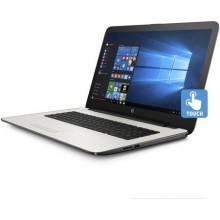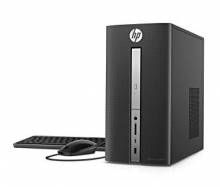Hp Pavilion 570 MT Intel Core i3 3.9GHz 4GB RAM 1TB Hdd Window 10 with HP 22" monitor
HP Pavilion 570-P054 MiniTower PC Z5P70AA
7th Generation
Intel Core i3-7100 3.90GHz
4GB DDR4-2133 SDRAM Memory
1TB 7200RPM SATA Hard Drive
Ultra Slim-tray DVD Burner
Window 10
Specs
Processor
Processor frequency
The speed that the microprocessor executes each instruction or each vibration of the clock. The CPU requires a fixed number of clock ticks, or cycles, to execute each instruction. The faster the clocks rate, the faster the CPU, or the faster it can execute instructions. Clock Speeds are usually determined in MHz, 1 MHz representing 1 million cycles per second, or in GHz, 1 GHz representing 1 thousand million cycles per second. The higher the CPU speed, the better a computer will perform.
3.9 GHz
Processor model
The model number for the processor in a computer.
i3-7100
Processor family
A family of processors is a group of processors produced by one company over a short period of time e.g. Intel Pentium processors.
7th gen Intel® Core™ i3
Processor cores
The number of central processing units ('cores') in a processor. Some processors have 1 core, others have 2 (e.g. Intel Core Duo) or more (e.g. the Intel Xeon E7-2850 has 10 cores).
2
Processor socket
Mechanical component(s) that provides mechanical and electrical connections between a microprocessor and a printed circuit board (PCB). This allows the processor to be replaced without soldering.
LGA 1151 (Socket H4)
Processor cache
3 MB
Processor cache type
Smart Cache
Processor threads
4
System bus rate
A bus is a communication system that transfers data between components inside a computer, or between computers. The system bus rate is the speed at which data is transferred in this communication system.
8 GT/s
Bus type
DMI3
Processor lithography
The process which is performed by the processor e.g. CPU (Central Processing Unit).
14 nm
Processor operating modes
Operating modes for the processors that place restrictions on the type and scope of operations for certain processes run by the CPU. This design allows the operating system to run with more privileges than application software.
64-bit
Processor codename
Kaby Lake
Thermal Design Power (TDP)
51 W
Tjunction
100 °C
PCI Express slots version
3.0
Maximum number of PCI Express lanes
16
PCI Express configurations
1x16,1x8+2x4,2x8
Number of processors installed
Number of processors in the product.
1
Stepping
S0
Maximum internal memory supported by processor
64 GB
Memory types supported by processor
DDR3L-SDRAM,DDR4-SDRAM
Memory clock speeds supported by processor
1333,1600,2133,2400 MHz
Memory channels supported by processor
Dual
ECC supported by processor
Storage
Total storage capacity
The total amount of data that can be stored on the device.
1000 GB
Storage media
Used for the storage of date e.g. HDD (hard disk drive), SSD (solid-state drive).
HDD
Number of storage drives installed
Amount of storage drives built into the device.
1
Number of hard drives installed
The number of hard drives built into the device.
1
Hard drive capacity
The maximum storage capacity of the hard disk, usually measured in bytes e.g. GB.
1000 GB
Hard drive interface
The way that a hard disk drive (HDD) is connected to the rest of the computer through a 'bus' such as ATA or SCSI.
Serial ATA
Hard drive speed
The rotational speed of a hard disk expressed in rotations per minute. The faster the better.
7200 RPM
Card reader integrated
The device includes a card reader e.g. a card reader in the disk bay of a computer or thin client to permit log-on using smart/pin cards.
Graphics
Discrete graphics adapter
Discrete graphics adapter model
A graphics adapter (often known as a video card) generates images for a display. A discrete graphics adapter plugs into the motherboard, and usually produces much better graphics than an integrated graphics adapter. There are various models of discrete graphics adapters.
Not available
On-board graphics adapter
Graphics hardware which is built into the motherboard or CPU, as opposed to a separate graphics adapter (video card). On-board graphics uses CPU and RAM for graphics processing.
On-board graphics adapter model
"Graphic adapter" is the hardware that produces images on a display. "On-board" means that the graphics adapter is intergrated inside the motherboard.
Intel® HD Graphics 630
On-board graphics adapter base frequency
350 MHz
On-board graphics adapter dynamic frequency (max)
1100 MHz
Maximum on-board graphics adapter memory
64 GB
Number of displays supported (on-board graphics)
The feature may not be available on all computing systems. Functionality, performance, and other benefits of this feature may vary depending on system configuration.
3
On-board graphics adapter DirectX version
12.0
On-board graphics adapter OpenGL version
4.4
On-board graphics adapter ID
0x5912
Optical drive
Optical drives quantity
The number of optical drives e.g. CD players/writers, DVD players/writers.
1
Optical drive type
An optical drive uses laser to read optical discs such as CDs, DVDs and Blu-Ray. Some types of optical drive are: CD ROM drive, CR-RW (CD writer) drive, DVD-ROM.
DVD Super Multi
Internal memory
A computer's memory which is directly accessible to the CPU.
4 GB
Internal memory type
The type of internal memory such as RAM, GDDR5.
DDR4-SDRAM
Memory layout (slots x size)
The slots and size of the memory for the CPU.
1 x 4 GB
Memory slots
Number and type of memory expansion slots, including connector and memory module descriptions.
2x DIMM
Memory clock speed
The frequency at which the memory (e.g. RAM) runs.
2400 MHz
Networking
Ethernet LAN
An Ethernet LAN (Local Area Network) interface is present, for a wired conection via a cable.
Ethernet LAN data rates
The different speed levels of the Ethernet LAN connection.
10,100,1000 Mbit/s
Wi-Fi
Popular technology that allows an electronic device to exchange data or connect to the internet wirelessly using radio waves.
Top Wi-Fi standard
IEEE 802.11ac
Wi-Fi standards
The type of wireless local area network (LAN). It can be ad-hoc, where units in a network communicate peer-to-peer, or Infrastructure, where units communicate with each other via an access point A LAN interconnects computers in a small area e.g. home, school or office.
IEEE 802.11a,IEEE 802.11ac,IEEE 802.11b,IEEE 802.11g,IEEE 802.11n
Bluetooth
Bluetooth is a low-power radio technology developed to replace the cables and wires currently used to link or connect electronic devices such as personal computers, printers, and a wide variety of handheld devices including mobile phones. Because it uses radio-wave connectivity, a Bluetooth-enabled device has a constant, established connection to whatever browser it uses. This saves the user the trouble of logging on to check for emails or news updates, for example.
Networking
Bluetooth version
The type of bluetooth technology in the product e.g. Bluetooth Smart (v4.0).
4.2
Ports & interfaces
USB 2.0 ports quantity
Number of USB 2.0 ports (connecting interfaces) in the device. USB 2.0 was released in April 2000 (now called "Hi-Speed"), adding higher maximum signaling rate of 480 Mbit/s (effective throughput up to 35 MB/s or 280 Mbit/s), USB 2.0 ports are usually black.
2
USB 3.0 (3.1 Gen 1) Type-A ports quantity
3
USB 3.0 (3.1 Gen 1) Type-C ports quantity
Number of USB 3.0 (3.1 Gen 1) ports with Type-C connector. USB 3.0 (3.1 Gen 1) is USB interface version which supports transfer rate up to 5 Gbit/s (SuperSpeed). USB Type-C connector has symmetrical design architecture and compatible with Thunderbolt 3 interface.
1
VGA (D-Sub) ports quantity
Number of VGA (D-Sub) ports (connecting interfaces) in the device. The VGA (D-Sub) connector is a 15 pin connector between a computer and a monitor. It was first introduced in 1987 by IBM.
1
DVI port
Digital Visual Interface (DVI) is a video display interface to connect a video source to a display device, such as a computer monitor.
HDMI ports quantity
The number of sockets (ports) for HDMI connections. HDMI (High-Definition Multimedia Interface) is a compact audio/video interface for transferring uncompressed video data and compressed/uncompressed digital audio data from a HDMI-compliant device ("the source device") to a compatible computer monitor, video projector, digital television, or digital audio device. HDMI is a digital replacement for existing analog video standards.
1
Ethernet LAN (RJ-45) ports
Number of Ethernet LAN (RJ-45) ports (connecting interfaces) in the device. Ethernet LAN (RJ-45) ports allow a computer to connect to the ethernet.
1
Microphone in
The socket where a microphone is connected to the device.
Line-out
Line-in
Combo headphone/mic port
Design
Chassis type
The type of rigid framework onto which is the hosuing for device components.
Mini Tower
Colour of product
The colour e.g. red, blue, green, black, white.
Black
Placement supported
Where the product can be placed e.g. indoor/outdoor, horizontal/vertical.
Vertical
Performance
Motherboard chipset
The chipset connects the microprocessor to the rest of the motherboard.
Intel® H270
Product type
The sub-category of the product.
PC
Software
Operating system installed
Type of operating system on a device e.g. IOS on Apple devices, Android for mobile devices.
Windows 10 Home
Operating system architecture
The way in which the operating system of a computer/smartphone (32-bit/64-bit) is set up.
64-bit
Processor special features
Intel 64
Enhanced Intel SpeedStep Technology
Embedded options available
Intel® InTru™ 3D Technology
Add a new dimension to your viewing experience. Now you can play games and watch your favorite 3D movies with Blu-ray Stereo 3D playback using passive or active shutter 3D glasses. InTru™ 3D technology by Intel in association with Dreamworks delivers it all in 1080p full high-definition resolution on your TV over HDMI 1.4.
Intel® Clear Video HD Technology (Intel® CVT HD)
See the World More Vividly Intel® Clear Video HD Technology delivers cleaner, sharper images, more natural, accurate, and vivid colors. View images as they were meant to be seen on devices featuring Intel® Core™ processors with Intel® Graphics Technology.
Intel Clear Video Technology
Intel VT-x with Extended Page Tables (EPT)
Intel TSX-NI
Idle States
Thermal Monitoring Technologies
Intel Stable Image Platform Program (SIPP)
Intel® AES New Instructions (Intel® AES-NI)
Added Security with Faster Data Encryption The Intel® Advanced Encryption Standard New Instructions (Intel® AES-NI) enable fast and secure data encryption and decryption for better performance and less risk from timing and cache-based attacks than table-based software implementations. Intel AES-NI supports usages such as standard key lengths, standard modes of operation, and even some nonstandard or future variants.
Intel® Secure Key
Generate Cryptographic Security Protocols Intel® Secure Key is a security hardware-based random number generator that can generate high-quality keys for cryptographic (encryption and decryption) protocols. These keys provide quality entropy that is highly sought after in the cryptography world for added security.
Intel® OS Guard
Protect Your Operating EnvironmentIntel® OS Guard, a hardware-based security feature that protects the operating system kernel, defends against malicious data or attack code located in areas of memory marked as user mode pages, preventing any application from taking over or compromising the OS kernel.
Intel Trusted Execution Technology
Execute Disable Bit
Intel Enhanced Halt State
Intel Software Guard Extensions (Intel SGX)
Intel® Clear Video Technology for Mobile Internet Devices (Intel CVT for MID)
Processor package size
37.5 x 37.5
Supported instruction sets
AVX 2.0,SSE4.1,SSE4.2
Processor code
SR35C
Scalability
1S
CPU configuration (max)
1
Write Your Own Review

















